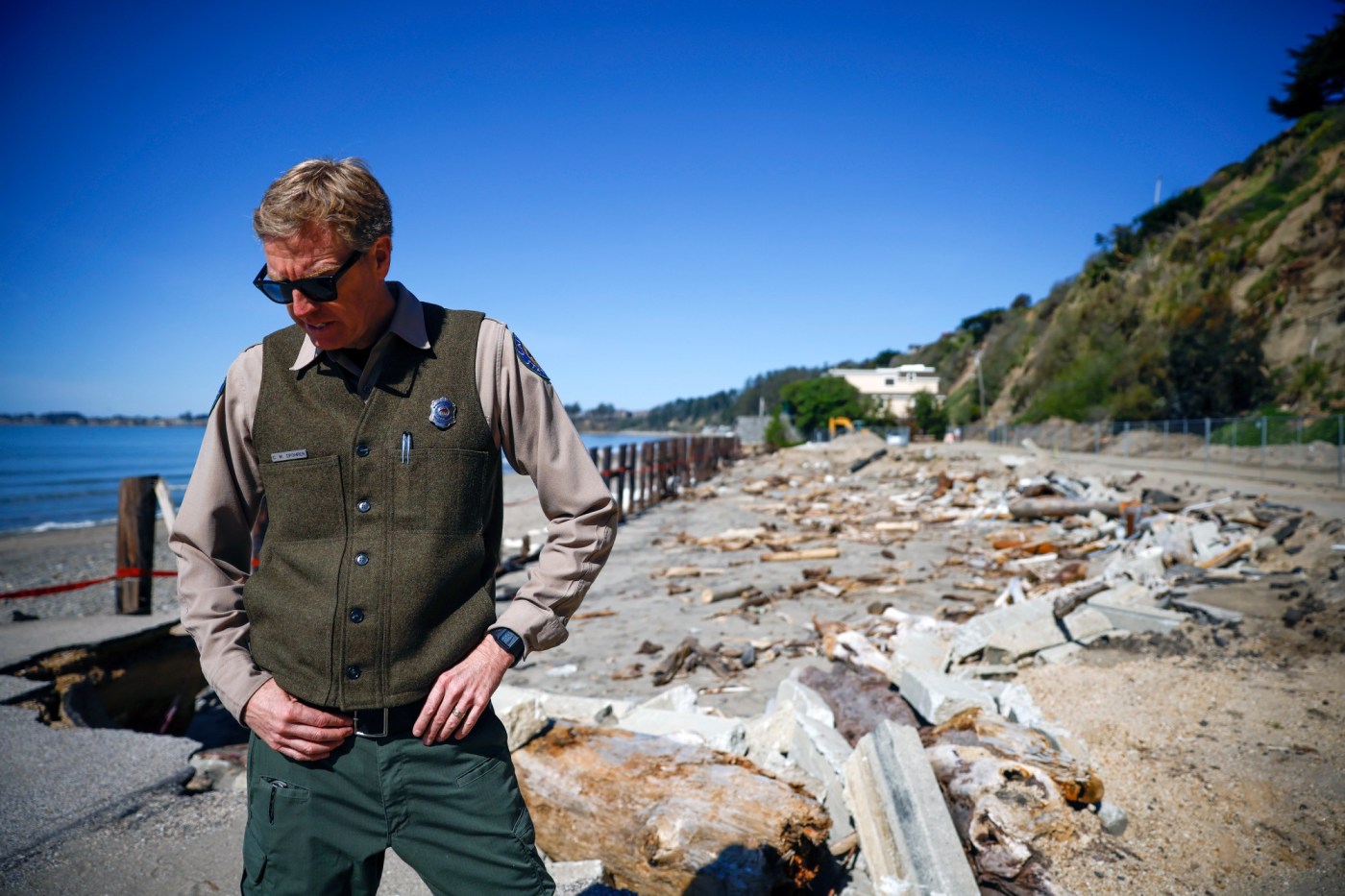
New study reveals major sea level rise vulnerabilities at Seacliff State Beach
APTOS — After more than a year of work, California State Parks has produced a 65-page report detailing serious vulnerabilities to climate change-fueled impacts at two popular oceanside destinations in Santa Cruz County.
But what exactly should be done about it remains an open question and the work to get some answers is just getting started.
State Parks, in partnership with its local operating partner Friends of Santa Cruz State Parks, hosted a community workshop at the Seacliff Inn in Aptos late last month to announce completion of the Sea Level Rise Vulnerability Assessment for Seacliff and New Brighton state beaches.
RELATED: Capitola Wharf, wrecked in huge winter storms, set to reopen after $10 million upgrade
The event drew interest from at least 319 residents that attempted to pack themselves into the typically spacious conference room at the hotel, but ended up spilling out into the parking lot.
‘An expectation’
Aptos residents made their preferences known at a community meeting last month when it comes to reimagining Seacliff and New Brighton state beaches in a way that adapts to the climate change era. (PK Hattis – Santa Cruz Sentinel)
The study, put together by consultant Moffatt and Nichol, revealed vulnerabilities at both beaches but the danger was most pronounced at Seacliff where, according to the study, 86% of the park’s assets along the beach and cliffside have been or will be exposed to coastal hazards resulting from sea level rise. At New Brighton, only 17% of those assets were at-risk.
And while the study was designed to assess a number of scenarios that play out over decades at the pair of contiguous beaches, state officials reminded the anxious crowd that the immensely damaging onslaught of winter storms in recent years are part of a new normal that has already arrived.
“As we have experienced the past couple of winters, it is likely that we will have multiple storm events where we’re going to have overtopping, where we’re going to have flooding and we will need to probably temporarily close for public safety some of the facilities there,” said State Parks Santa Cruz District Superintendent Chris Spohrer at the Sept. 26 meeting. “That should be an expectation.”
The study assigned vulnerability ratings to various categories of park facilities within four sea level rise scenarios: one foot by 2050, two feet by about 2070, four feet by 2100 and six feet also by 2100, to account for underestimations in the models. At one foot, all assets including park facilities and infrastructure, recreation, public access, natural resources and cultural resources fall into the “low” impact category. By two feet, facilities and infrastructure, recreation and public access move into the “moderate” category, but escalate to “severe” or “high” at four feet. By six feet, all of the assets are within “severe” or “high” impact levels.
Some of the endangered facilities at Seacliff include the visitor center, a seawall, multiple bathrooms, the campground as well as gas, electrical, sewer lines running underneath the road along the shoreline.
“It gives us an opportunity. We have to look at it this way,” said Spohrer. “It gives us an opportunity to be visionary and think forward about the future with all of you about how we can redevelop these parks to make them resilient to what we know is a changing climate and those impacts that we’re seeing.”
How we got here
Related Articles
Sea lion found on California beach was shot; $20,000 reward offered
‘Loophole’ in state law opens door to 22-story high-rise close to a California beach
Map layout updates to be considered by California Coastal Commission
Missing woman rescued by helicopter after being stranded on Monterey County beach for more than 24 hours
California shark attack rescuers earn medal for heroism
The vulnerability assessment has emerged from the aftermath of a parade of atmospheric river storms that slammed the county’s coastline in early 2023. Torrential rain, high winds and massive swells crippled the Seacliff pier and necessitated its demolition, severely damaged the park’s seawall, eroded the coastal bluffs and washed out much of the fill material and underground infrastructure in the campground which remains closed.
Though there was an understandable rush to get the park cleaned up and ready for basic uses, state and local officials said the storms warranted a more thoughtful long-term rebuild given that climate change is causing seas to rise over time and is producing frequent and severe storms.
Bonny Hawley, executive director of Friends of Santa Cruz State Parks, explained that the recovery project in Aptos takes a page from another ongoing disaster rebuilding plan at Big Basin State Park after it was decimated during the 2020 CZU Lightning Complex Fire. The environments are much different, she noted, but the intention was to reestablish facilities at Big Basin in a way that is adaptive to a hotter, drier future.
“Big Basin was an opportunity–and is an opportunity–for the community to come together to imagine a more vibrant, resilient redwood park,” said Hawley. “What has happened at Seacliff is giving us all the opportunity to work towards a more resilient coastal park in the era of climate change.”
After a brief introduction, event attendees were invited to peruse the event space and visit various stations offering a deep dive into the study and its results as well as chances to share more about favorite activities at the parks, preferred landscaping scenarios and dreams of how the park could look in an imagined future of 2045.
Johanna Lighthill has lived in the Seacliff area for 21 years and walks along its scenic shoreline on a frequent basis. She said the storms from the last few years have shaken local residents and she hopes to see a plan that preserves public access to the open areas.
“Everyone is concerned about what lies ahead,” said Lighthill. “It’s kind of like a mascot of our neighborhood just kind of wearing away.”
More work ahead
According to Spohrer, the Federal Emergency Management Agency was made available at Seacliff and New Brighton to support the immediate recovery of the parks after the 2023 storms. Now, State Parks are in talks with the federal disaster agency to determine how much in-kind financial support can be given for reconstruction of facilities that were damaged in those storms, but a figure as of late September was yet to be agreed upon.
“It’s a process; it takes time,” Spohrer told the Sentinel. “It’s not the sort of thing where you have a bunch of money immediately upfront to start the rebuild.”
He added that the FEMA money, when it does come through, still won’t be enough to cover the park adaptation enhancements envisioned by the community. The hope, he said, is for that money to come through the state legislative process, private donations or philanthropic initiatives.
Separate from the FEMA process, Friends’ own Seacliff Recovery Fund had raised more than $118,000 in private donations as of late September, according to Hawley, and has been used for short-term recovery support and now long-term recovery work at the parks.
In addition to the Sept. 26 meeting, State Parks will also host a similar workshop online from 6-7:30 p.m. Oct. 21.
After more community feedback is collected in the coming months, State Parks will develop an alternatives analysis describing proposed facility and location adaptation scenarios that will again be shared with the community for further input potentially by next spring, said Spohrer.
If you go
What: Seacliff and New Brighton state beaches Sea Level Rise Vulnerability Assessment community workshop.
When: 6-7:30 p.m. Oct. 21
How: Online. Register at seacliffresilience.org/meetings
*Study available at seacliffresilience.org


